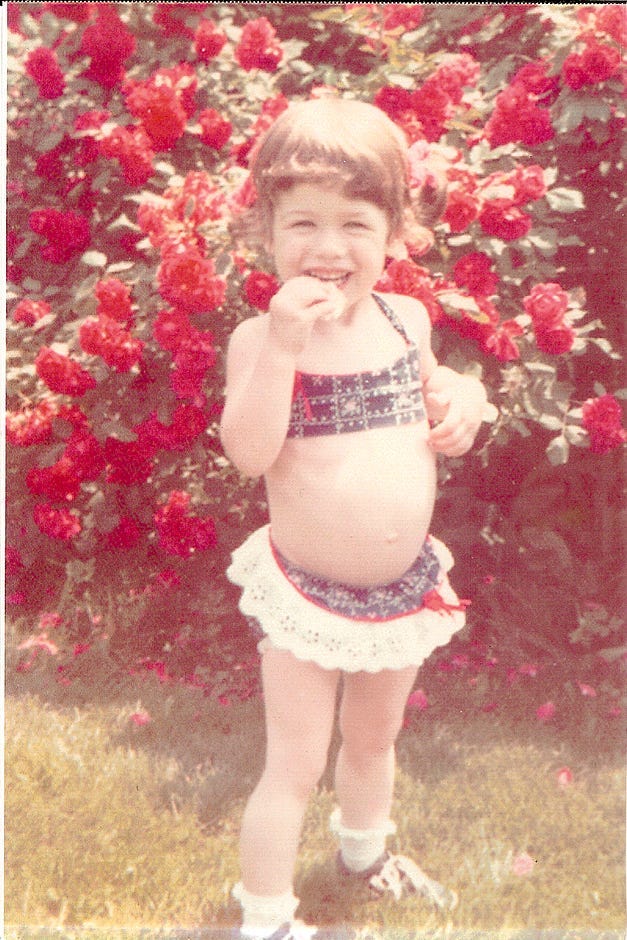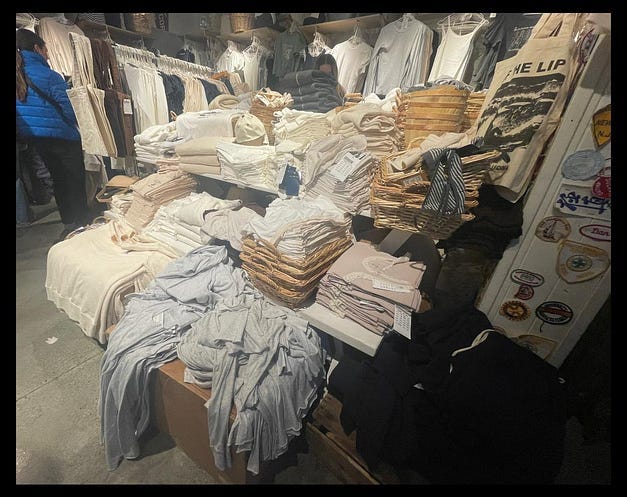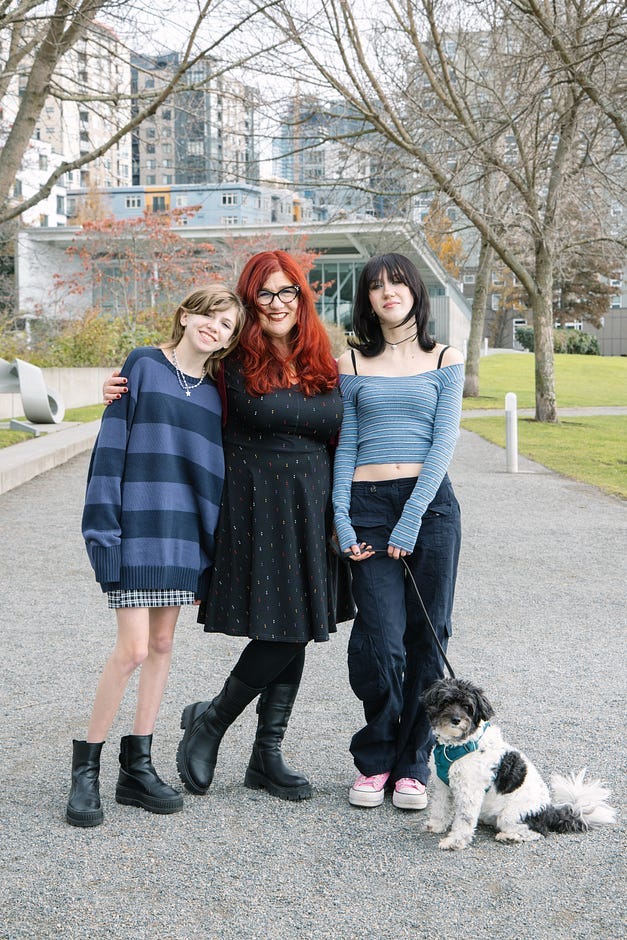A Gen X Mom Mulls the Weight of Beauty and Brandy Melville
Does the fat-shaming generational circle of life ever end?

It’s late 1988, and I’m home from my freshman year in college for holiday break. I’ve landed a retail gig working at Contempo Casuals in our local mall, peak fashion for the era. As a natural born extrovert with a good eye for outfits, I’m excellent at this job.
Today I’m helping a girl who’s probably not much younger than I am, but now that I’m in college, a 3–5 year age gap is a maturity chasm. She’s still got a bit of what we’d call baby fat — she’s not obese by any stretch, but also not skinny enough to fit into the clothes she wants to buy.
It’s clear that while the girl is frustrated by her lack of height-of-mall-fashion options, her shopping companions are horrified, making her disappointment spike to mortification.
This poor child is in the fitting room with her mother and grandmother. Overly made-up and tanned, and less than 1,200 calories per day eaters by the look of them, they’re tsking and clucking, shaking their heads at the shame of her extra 5–10 pounds as if it’s a moral failure.
To them, I’m sure it is.
I can see on her face how it feels that way to her, too.
I’m not skinny — I haven’t been since I hit puberty — but at 18 years old, I’ve lost my baby fat. But I haven’t lost how it feels, to know ones progenitors are judging your body and you’re coming up short — or rather, fat.
I come from a line of “diet tomorrow” women, and in 1988 I have no idea women can have alternate views about their appearance. I thought my weight, my appetite, my body were the problems. Sure, I’d slimmed down a bit by late high school, but I still wasn’t anything ideal in terms of my appearance. I’ve never been the beauty my grandmother was or mother is, and I think I always knew it, even as a child.
When her family leaves her in the room to change, I pop back in to collect her unwanted try-ons. I can see she’s teary.
“Don’t worry,” I tell her, “I couldn’t fit into clothes like this at your age either. But then my body slimmed down on its own during my senior year in high school. It’ll be okay.”
She smiles at me, grateful for some compassion.
At the time, it felt good to help this girl in her moment of shame. I hadn’t thought about this memory in many years. But when I sat down to write about my own path of dieting and weight, her teary eyes — and the judgments of her female elders — came forward first. Maybe it softened the blow, to think of her plight before considering my own?
Either way, I felt a wave of compassion for that troubled girl in the fitting room — actually, for both of us.
It was hard coming of age as the baby fat girl.
I was skinny as could be as a little kid. “Skinny Minnie,” my Grandfather used to call me, and he’d prove me worthy of the moniker by demonstrating how he could touch his thumb and middle finger around my thigh. Yep, I sure was skinny, and I guess I smiled at this weird nickname for “Dana” and assumed it was a compliment? Girls want to be skinny, right?
Then I hit puberty.
I went to sleep-away camp, a rustic spot called Three Pines in the mountains of Maine where we tweens ran feral for four weeks. I loved it. I had no awareness of how much my body changed (which itself is kind of a revelation), but my mom describes feeling stunned upon my return by how my body had bloomed. I was curvy, a C-cup by seventh grade. What can I say, I’ve always had amazing boobs.
Wait, I can say more than that.
I can say: back then, no one called me curvy. I was chubby.
My familial nickname changed from “Skinny Minnie” to “Crisco,” because I was “fat in the can.” I didn’t even get that joke till adulthood, but I do recall my Mom telling me my Grandfather had called her the same at my age.
No one seemed to think this was strange, or demoralizing, or required adult intervention — not for my Mom in the 60s, nor for me in the 80s.
Back then, it was normal. Fat in any way, shape, or form (literally) was bad, something worthy of ridicule. So we took it.
When I slimmed down during in high school, I don’t recall changing my diet or exercise; it was just nature doing its thing. Now as an adult, I know this is common for female puberty. The development from girl-body to woman-body can vary in how one grows up versus out.
I happened to first grow “out” a bit more than societal — and my family of origin — norms liked.
“Diet tomorrow.” This was the droning mantra of my childhood, the women’s lament for the caloric excess of our family dinners. Every visit with my Grandparents — which always involved a delicious dinner at the Rascal House, some of the fondest memories of my childhood— would be followed by my Grandmother and Mom bemoaning their meals, confessing for their gustatory excesses, and committing to atone the next day with denial.
“Ooh, I was so bad,” they’d say.
I marvel that I escaped my upbringing with a robust appetite, and without an eating disorder.
The women in my family valued denial over indulgence, famine over feast.
I don’t mean literally. We’ve never wanted for food, and they never starved themselves. But for the women who raised me, staying in control — and staying thin, always thin — has always been the moral high-ground over indulgence.
Yet intuitively, I’ve always known I’m more of a feast than famine sort. It must be built into my DNA to have sustained through the upbringing I had, in the culture we all live in.
I hold it as a mark of pride, not shame. Mostly.
And so I endured the nicknames, I empathized with that kid in the fitting room, and I grew up. In typical Gen X fashion, I had to eye-roll the expectations and persevere, an unstated “whatever” filling the gap between me and the skinny beauty standards I could never attain. I knew my brains, writing skills, taste in music, and passably cute looks were going to have to suffice.
I had no idea that a couple decades later the culture would shift away from skinny as the only option. It was Millennials who would grow up and insist we challenge our fat-phobic culture, but as I came of age they were still in grade school — probably already cognizant of their own body issues but unaware of the seismic changes they’d collectively make to move public opinion, as well as fashion industry and beauty norms.
Plus-size wasn’t part of fashion in the 80s, and anyone who couldn’t fit in the clothes just quietly resigned themselves to fewer, less stylish options.
In hindsight, I don’t see the advice I gave the girl in the fitting room as wise, even if it may have provided temporary comfort. I wish I could go back now and tell her — and myself — how your self-worth shouldn’t be wrapped up in a pair of size 4 designer jeans.
Bodies can be beautiful and strong at any size, I should have said, and your appetites exist for pleasure and should be explored and indulged, as they give life joy and meaning. Relish them.
But I also don’t harsh my younger self too much. From my 1988 vantage and upbringing, how could I have known how my own views — and the broader zeitgeist — would expand?
I wish I’d known.
I wish all of us who grew up in a one-size-doesn’t-fit-all body could have glimpsed a world where Lizzo and Lindy West and Christina Hendricks and Lena Dunham and Rebel Wilson and all other bodies of different shapes, sizes, and colors weren’t hidden, but were flaunted, celebrated even.
I love that many fashion brands now carry clothes — super cute clothes! — from size 0 to 40, that women don’t simply fall off a fashion cliff once they shoot past a size 12. It’s not just a nicety either, it’s an expectation. I’ve seen many brands eviscerated in their social media advertising if they don’t feature inclusive sizing, both in their warehouses and in their marketing campaigns.
So many things are so hard for women right now. But looking back at 1988, I’m pleased with how this particular issue has evolved.
Mostly.
Now I’m raising two amazing teen girls. They’re the benefactors of generations of work done by women before them, especially about body acceptance.
As their mother, I know they’re learning about their relationships with food from me. I’ve tried to model the best, most nonjudgmental behavior I can. I never lament the size or shape of my body. I wear swimsuits with abandon. When I do change my diet, I talk about the health benefits, not aesthetic ones. If my Mom starts her “diet tomorrow” talk, I ask her to not use that language in front of my kids.
I encourage my kids to enjoy food, to indulge in treats but also make healthy choices. I’ve raised them to see food as both a fuel and a source of joy. I don’t restrict portion sizes, nor do I force them to clean their plates.
I’m doing everything I can to break a multi-generational cycle of body shame.
And they get it. They don’t use “fat” as a pejorative. These Gen Z children of mine, like so many of their peers, are inclusive nearly to a fault. They exude body positivity and consider themselves anti-racist, allies, and feminists. They’re anti-bullying. They know beauty comes in all shapes and sizes. They’re aware of fast-fashion and the harm it came do.
And yet.
Where do my kids and all their Gen Z peers all want to shop?
Brandy Melville.
For the unindoctrinated, Brandy Melville is a clothing store for young women. To my eyes, their clothes are aggressively uninteresting, a messy pile of neutral nothingness…

Know what makes the store so appealing, and also so controversial?
Brandy Melville is one size fits all.
Which is to say, they have no sizing options. Just size Brandy.
To me, Brandy Melville may look like a blur of boring cloth. But to these kids, they see details and nuances that signal to all of their peers: I am wearing Brandy Melville.
Or framed slightly differently: I can fit into Brandy Melville.
This means even now we have a new generation of kids coming of age while crying in fitting rooms because they’re not skinny enough to fit into the clothes they want to buy. It’s confounding. It’s disheartening. And yet, it’s what the kids want to wear.
My children are built like their father, not me. They’re ectomorphs, long and slender.
They have no baby fat.
They fit into size Brandy just perfectly.
I’m grateful, but conflicted. In spite of so many hard-won victories, the paradox of their Brandy-obsession makes the fight for body acceptance feel like a cyclical process of generational fat-shaming, an ouroboros of a serpent curving in on itself and eating its other end, and somehow returning to that mall fitting room in south Florida in 1988.
Perhaps it’s even more unkind now. Even Contempo Casuals clothes had a size range.
From my Gen X perspective, I can see both the progress and the regressions. Sure, now we’ve got Brandy Melville — but we also have Torrid. I know that’s a false equivalency but hey, it beats crying the fitting room of Contempo Casuals.
Now we have options.
I’m a Gen X mama of Gen Z girls. I’m weary, but I also can’t view these decades of advocacy as futile. So I will take the incremental progress as a win, and I will also buy my kids the Brandy outfits they want.
Oh well, whatever.
The generational cycle carries on…




This once “husky” kid felt this in his bones.
Beautifully written and expressed. Thanks for addressing this issue. I’ve done a lot of therapy over the last year and am coming to terms with my body image issues, but part of me is still that kid who wore a t-shirt over her bathing suit at the pool.